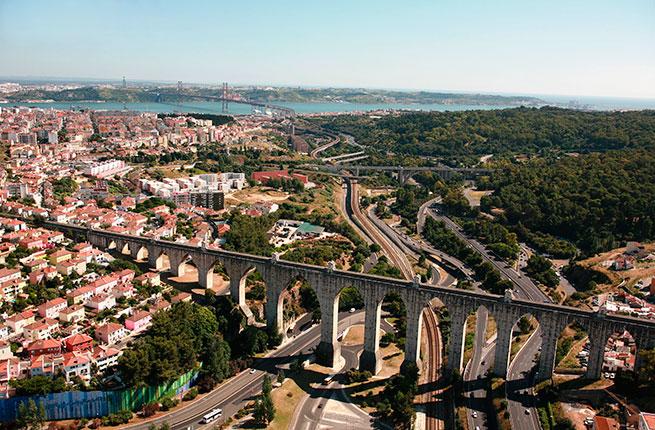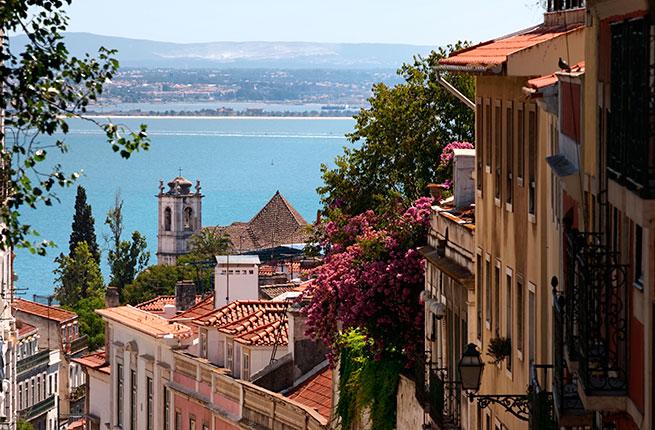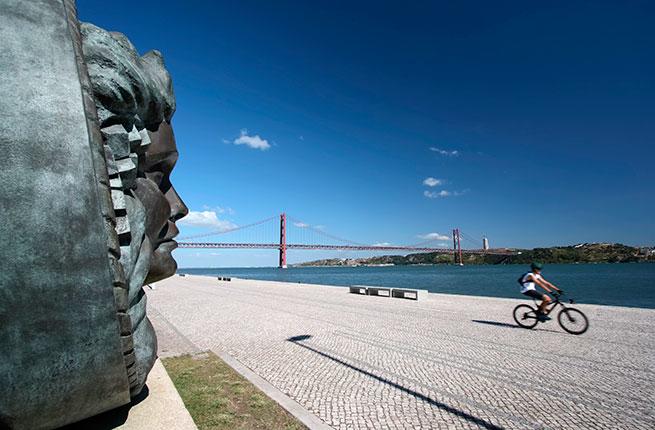Picturesque Lisbon has finally emerged from the shadow of flashier European cities such as Paris, Rome, and Barcelona. Visitors are attracted by the coastal capital’s many charms—historic castles and palaces, beautiful parks and plazas, gorgeous boutique hotels, and a packed cultural calendar are just the start. Surprisingly affordable prices are the icing on the cake.
A long weekend in Lisbon is just enough time to admire the architecture, ride the antique trams, take in the views, dine at Michelin-starred restaurants, sip a sour cherry liqueur, listen to the melancholic strains of the city’s fado music, and party late into the night at lively clubs and bars. The city is hilly but compact, and getting around is an experience in itself, with vintage trams, electric bikes, and tuk-tuks to whisk you up the steep inclines.
Be warned, though, a weekend may not be long enough to fully sate your appetite—gorgeous beaches and fairytale-esque towns lie just outside the city, but you’ll have to leave those for your next visit.
Friday

Paying for public transport in Lisbon can be a hassle, so the first thing you should do on arrival at Lisbon airport is pick up a Lisboa Card ($21 for 24 hours, $43 for 72 hours) from the tourist information kiosk. As well as offering free or discounted entry to most of Lisbon’s tourist sights, the card also offers unlimited rides on public transport, allowing you to hop on and off buses, trams, metros, and trains throughout the weekend. Leaving the airport, skip the taxi queue at arrivals and take the escalator up to departures, where you’ll be able to grab a cab straight away.
Recommended Fodor’s Video
Once you’ve freshened up, head out to admire the gleaming white marble dome and ornate interior of the 18th-century basilica. The construction of the church was ordered by Queen Maria I to give thanks for the birth of a male heir, and her remains are buried here. Don’t miss the intricate nativity scene created by the great Portuguese sculptor Machado de Castro.
Outside the Basilica, join the queue for the famous 28 Tram. These historic streetcars clank along the steep hills and sharp twists of Lisbon’s back streets, offering a moving tour of some of the city’s most famous attractions. Jump off at the Castle to spend an hour or so soaking up the history and getting the lay of the land from the ramparts, beneath which the entire city spreads out in front of the river.
Take a 10-minute stroll downhill to reach the Cathedral, unmissable thanks to its two imposing, turreted clocktowers. The oldest of Lisbon’s many religious buildings, the church is patchwork of Baroque, Gothic, and Romanesque styles.
After a nerve-jangling bica (strong espresso) and energy-boosting queijada (sweet cheese tart) from the retro-chic kiosk in front of the Cathedral, continue your descent to the lower reaches of the city, and the grand Praça do Comércio. Formerly the site of the Royal Palace, it remains Lisbon’s grandest square, flanked by 18th-century buildings that today house bustling cafés, museums, and bars, framed by the impressive Arco da Rua Augusta on one side, and the River Tagus on the other.
You’re sure to have built up an appetite by now, so stroll along the waterfront until you reach Monte Mar, where you can enjoy the culinary benefits of Lisbon’s location at the point where river meets ocean. Monte Mar is a sister restaurant to the legendary Cascais eatery, whose seafood has enticed everybody from rock stars to visiting politicians (Bill Clinton has been there). The Lisbon branch has a more casual vibe but the same focus on quality seafood. Ask for a table on the terrace to gaze over the river and the 25 de Abril suspension bridge to the Cristo Rei statue on the other side, as you tuck into appetizers of garlicky marinated olives, followed by siesta-inducing mains such as pescada com arroz de berbigao (hake with rich cockle rice). A half bottle of vinho verde will wash it down nicely.
After lunch, grab a cab or tram back to your hotel for a nap before heading out to see the sunset from Miradouro de São Pedro de Alcântara. It’s a 25-minute stroll or leg-saving cab ride of around 8 euros. Fountains, food and drinks kiosks, and street musicians set the scene for the show as the sun dips over the horizon, setting the castle and the city below it aglow.
You’re right at the heart of Lisbon’s buzzing nightlife, the Bairro Alto, so take your pick from fado houses, hipster hangouts, and restaurants with tables and chairs out on the sidewalk. Instead of formal dining, we recommend heading from bar to bar, nibbling petiscos (the Portuguese version of tapas) as you go. Start your culinary journey at Solar do Vinho do Porto, where you can lounge in an armchair and snack on cured meats and aged goat's cheeses from nearby Azeitao as you sip port wine. From there, see where the night takes you—the partying goes on until the wee hours in this part of town, taking on a street party vibe around midnight.
Saturday

Banish any threat of a hangover with strong black coffee, freshly squeezed juice, and buttery pastries before heading to Jardim da Estrela. Lisbon has many leafy public parks, and this is one of the loveliest, with fish-filled ponds, jumping fountains, and casually chic cafés. Pick up gifts at the weekend handicrafts museum, and take a half-hour walk or quick cab ride down the hill to newly trendy Alcantara to join the artsy crowds at LX Factory. At this industrial-chic spot, a collection of abandoned 19th-century warehouses has been transformed into a symbol of Lisbon’s creative spirit, and is the hangout of choice for Lisbon’s hipsters. Look out for works by renowned street artists such as Pedro Zamith and Bordalo II as you browse bookstores, art studios, and boutiques selling funky bikinis, cork-soled sandals, and handmade jewelry. There are any number of places to sip a craft beer, or you might opt to have your nails painted or get your hair styled. You could even get a new tattoo, if you didn’t have such a packed sightseeing agenda.
From this icon of contemporary cool, it’s a one-stop hop on the train to the historic charms of Belém, where not one but two UNESCO World Heritage Sites lie within a stone’s throw of one another. Begin your history lesson at Pasteis de Belém, the legendary café that has been serving delicious pasteis de nata (rich custard tarts) since 1837. Eat them warm from the oven with another energizing bica before priming your camera for action at Belém’s showstopping centerpiece, the Mosteiro dos Jerónimos. This ornate UNESCO World Heritage Site was built in 1502 at the behest of King Manuel I, and the combination of Gothic architecture and intricate sculptural details came to be known as Manueline style. It was here that Vasco da Gama spent his last night before sailing to India, and his tomb is housed here.
Once you’re done ogling at the level of detail in the carved nautical motifs, you should make Belém Tower—another UNESCO World Heritage Site—your next stop. Built in 1515 to defend the city from attacks, the Torre de Belém rises stark out of the water, with grand balustrades, sentry houses, and cupolas that are notable for their Moorish influence. Those who make the steep climb to the top of the towers are rewarded with spectacular views over the river and the grand architecture of Belém.
When you’re done, treat yourself to a glass of wine to go from Wine with a View, a “wine cart” selling quality Portuguese vinho in disposable wine glasses at key sightseeing hotspots. From there, it’s two stops to Cais do Sodre, a newly hip part of downtown that’s a former red-light district transformed into a hub for trendy bars, restaurants, and boutique hotels.
Browse for treats at the Mercado da Ribeira, where Lisbon’s grandest market building has been transformed into a smart collective dining space. There are a dozen or so restaurant kiosks serving local specialties ranging from fresh lobster and crab to creamy goats’ cheese from nearby Azeitao. Try Portugal’s famous sour-cherry tipple (from a chocolate cup, if you want to double up on the sinfulness) at Ginja de Obidos before taking a tram or tuk-tuk back to your guesthouse to nap and change before heading out for a dinner to remember at Belcanto, in chic Chiado. Navigating the route can be a little tricky amid the crush of tourists, so take a cab if you want to avoid the hot-and-flustered look. Chef José Avillez has won two Michelin stars for his modern renderings of classic dishes at this intimate 10-table restaurant. The imaginatively-titled signature dish ‘Garden of the Goose that Laid the Golden Egg’ involves an egg coated in edible gold leaf, and is a prime example of his unique take on molecular gastronomy. As foodie experiences go, Belcanto is up there with the best of them, and it’s not absurdly expensive either—mains average at $50, and tasting menus (highly recommended) start at $140. Another $55 gets you five carefully paired wines.
Assured of your super-trendy dining credentials, head down to the lively ‘Pink Street’—the affectionate moniker given to Rua Nova do Carvalho in Cais do Sodre—to join the fashionable masses as they flit from one gin bar to another until well into the small hours. If you visit just one spot here, make it the Pensão Amor, whose name and burlesque decor pay homage to the building’s past life as a bordello. Its rebirth as a treasure trove of small bars, cafés, and occasionally racy shops kick-started the gentrification of this formerly downtrodden area.
Sunday

Make today your shopping day. After breakfast, take a stroll (admiring the street art and ornate tiles as you go) to the fashionable Principe Real neighborhood, stopping en route for coffee. The well-maintained streets of Principe Real are lined with trees, kiosks, and smart boutiques—there are more Portuguese designers based here than anywhere else in the city. Admire the grandeur of the Embaixada (Embassy), where designers have set up shop over two floors of a wonderfully opulent building. Don’t worry if you blew the budget on last night’s dinner—window shopping is a big part of the draw. Pay a visit to the neighborhood’s gardens. Flanked by grand buildings including the neo-Moorish Palácio Ribeiro da Cunha, the Jardim de Principe Real has two kiosks serving snacks and drinks; either is ideal for an afternoon pick-me-up. If you’re after something a little more sophisticated and you aren’t in a hurry, try your luck at the no-reservations A Cevicheria, currently one of Lisbon’s hottest restaurants. Chef Kiko Martins serves stellar versions of Peru’s national dish, given a Portuguese flavor thanks to the use of locally sourced fish.
From Principe Real, it’s a pleasant stroll to the grand plazas and pedestrianized streets of Rossio. Take a walk along Rua Augusta, in time to make a sunset ascent to the top of the triumphal arch to enjoy one last por de sol over the city. After dark, make your way to the steep cobbled streets of Alfama, the home of fado music. Tourist traps abound here, but superb fado is guaranteed at Mesa de Frades. Around $50 buys you a hearty meal, free-flowing wine, and the chance to hear sumptuous singing and the unique sound of the Portuguese guitar in this cozy, candlelit casa de fado. Be prepared for a late night, since the music only gets going after 11 pm.
When to go
There’s no wrong time to visit Lisbon, but the city offers very different experiences depending on the time of year. During the July–August high season, the sound of live music and DJ sets fills parks and plazas, temperatures soar, and prices rise in tandem with the mercury. May and June are both cooler and quieter, with the exception of the hugely busy “Popular Saints” festivities in the middle of the month. September sees tourist numbers and prices drop, while temperatures are still warm. Weather becomes more unpredictable from October through April. Not to fear though, as outdoor cafés supply blankets when temperatures dip, vendors sell hot chestnuts on every corner, and the kiosks swap the summer sangria for hot spiced wine.
Where to Stay
Base yourself close to public transport links in order to nip up and down the seven hills with ease. Estrela Park is the perfect casual-chic spot close to the 28 tram stop but away from the tourist hordes, and it’s on budget too. It’s a real home-away-from-home experience, assuming your home looks like it’s straight of a style magazine. If there’s no room at the inn or you want to go a little more luxe, book into the stylish LX Boutique down the hill in hip Cais do Sodre, where you’ll be within easy reach of a main metro/train/tram and ferry hub, as well as being well-placed for sightseeing, shopping, and nightlife.




